Multi-Scenario Land Use Simulation and Cost Assessment of Ecological Corridor Construction in Nanchang City
Abstract
Highlights
- At the city scale, land-use policies oriented toward ecological protection are the most economically efficient with the lowest corridor construction costs.
- Minimizing ecological corridor construction costs at the district level in Nanchang requires differentiated development scenarios rather than a uniform ecological protection scenario.
- One-size-fits-all policies overlook local complexities and are suboptimal for urban management and spatial planning.
- Quantifying corridor costs under multiple scenarios provides a robust decision-making framework for sustainable urban governance.
Abstract
1. Introduction
2. Materials and Methods
2.1. Study Area
2.2. Data Sources and Processing
2.3. Research Framework and Methodology
2.3.1. Ecological Corridor Extraction Based on MCR Model
Identify Ecological Sources
Construct the Ecological Resistance Surface
Extract the Ecological Corridor
2.3.2. Multi-Scenario Design
2.3.3. Land Use Simulation Based on PLUS Model
2.3.4. Cost Assessment of Ecological Corridor Construction
3. Results
3.1. Spatial Distribution of ECs in Nanchang
3.2. Multi-Scenario Land Use Simulation Results of Nanchang in 2035
- (1)
- Under the EP scenario, cropland conversion is constrained, and urban expansion is limited within designated development boundaries. Water bodies experience the smallest reduction in area (0.51%), while arable land, forest land, and grassland decrease by 2.73%, 3.66%, and 2.92%, respectively. Construction land expands by 98.16 km2, representing a 13.78% increase.
- (2)
- In the ND scenario, forest land undergoes the largest decline (4.49%), followed by cultivated land (3.91%), grassland (3.10%), and water bodies (0.76%). Construction land increases significantly in area, with a total growth of 21.58%.
- (3)
- Under the UE scenario, construction land exhibits the greatest expansion, with an increase of 28.16%. In contrast, arable land, forest land, and grassland contract further.
3.3. Impact of Multi-Scenario Land Use on the Ecological Corridor
3.4. Cost Assessment of Ecological Corridor Construction Under Multi-Scenario Land Use Simulation
4. Discussion
4.1. Comparison of Ecological Corridor Construction Costs Under Multi-Scenario Development
4.2. Diversity in Scenario Selection
4.3. Implications for Corridor Construction and Management
4.4. Limitations of the Study and Future Work
5. Conclusions
- (1)
- Ecological corridors exhibit pronounced spatial heterogeneity, with dense concentrations in the ecologically rich northern and southeastern regions, whereas the highly urbanized central core shows a sparse distribution.
- (2)
- By 2035, the overall land-use structure in Nanchang City is projected to remain generally similar across the three development scenarios. However, the magnitude of change within individual land-use categories varies considerably across scenarios.
- (3)
- Significant differences in total construction costs are observed among the three scenarios, with the EP scenario producing the lowest overall cost and the UE scenario yielding the highest expenditure. These results underscore the effectiveness of ecological protection policies in supporting ecological functions.
- (4)
- At the district level, the EP scenario generally results in the lowest corridor construction expenditures. Notably, Honggutan District deviates from this pattern due to its high land values and substantial reserves of developable land, emphasizing the need for district-specific strategies that account for local socio-economic and ecological conditions.
Author Contributions
Funding
Data Availability Statement
Acknowledgments
Conflicts of Interest
References
- Harris, L.D. The Fragmented Forest: Island Biogeography Theory and the Preservation of Biotic Diversity; University of Chicago Press: Chicago, IL, USA, 1984; pp. 153–170. [Google Scholar]
- Zhu, M.; Zhu, D.; Huang, M.; Gong, D.; Li, S.; Xia, Y.; Lin, H.; Altan, O. Assessing the Impact of Climate Change on the Landscape Stability in the Mediterranean World Heritage Site Based on Multi-Sourced Remote Sensing Data: A Case Study of the Causses and Cévennes, France. Remote Sens. 2025, 17, 203. [Google Scholar] [CrossRef]
- Bai, X.; Shi, P.; Liu, Y. Society: Realizing China’s urban dream. Nature 2014, 509, 158–160. [Google Scholar] [CrossRef] [PubMed]
- Gong, D.; Dong, D.; Du, H.; Zhou, Y.; Fu, S.; Fujioka, Y. Spatiotemporal coupling mechanisms and driving forces of ecosystem services and human activity from a multidimensional perspective. Int. J. Digit. Earth 2025, 18, 2512061. [Google Scholar] [CrossRef]
- Liu, Y.; Fang, F.; Li, Y. Key issues of land use in China and implications for policy making. Land Use Policy 2014, 40, 6–12. [Google Scholar] [CrossRef]
- Huang, M.; Zhong, S.; Ge, Y.; Lin, H.; Chang, L.; Zhu, D.; Zhang, L.; Xiao, C.; Altan, O. Evaluating the Performance of SDGSAT-1 GLI Data in Urban Built-up Area Extraction from the Perspective of Urban Morphology and City Scale: A Case Study of 15 Cities in China. IEEE J. Sel. Top. Appl. Earth Obs. Remote Sens. 2025, 18, 17166–17180. [Google Scholar] [CrossRef]
- Long, H.; Qu, Y. Land use transitions and land management: A mutual feedback perspective. Land Use Policy 2018, 74, 111–120. [Google Scholar] [CrossRef]
- Haddad, N.M.; Brudvig, L.A.; Clobert, J.; Davies, K.F.; Gonzalez, A.; Holt, R.D.; Lovejoy, T.E.; Sexton, J.O.; Austin, M.P.; Collins, C.D. Habitat fragmentation and its lasting impact on Earth’s ecosystems. Sci. Adv. 2015, 1, e1500052. [Google Scholar] [CrossRef]
- McKinney, M.L. Urbanization, biodiversity, and conservation: The impacts of urbanization on native species are poorly studied, but educating a highly urbanized human population about these impacts can greatly improve species conservation in all ecosystems. Bioscience 2002, 52, 883–890. [Google Scholar] [CrossRef]
- Sun, H.; Huang, M.; Lin, H.; Ge, Y.; Zhu, D.; Gong, D.; Altan, O. Spatiotemporal dynamics of ecological environment quality in arid and sandy regions with a particular remote sensing ecological index: A study of the Beijing-Tianjin Sand source region. Geo-Spat. Inf. Sci. 2025, 1–20. [Google Scholar] [CrossRef]
- Yang, S.; Zhao, W.; Liu, Y.; Wang, S.; Wang, J.; Zhai, R. Influence of land use change on the ecosystem service trade-offs in the ecological restoration area: Dynamics and scenarios in the Yanhe watershed, China. Sci. Total Environ. 2018, 644, 556–566. [Google Scholar] [CrossRef]
- Wang, S.; Wu, M.; Hu, M.; Fan, C.; Wang, T.; Xia, B. Promoting landscape connectivity of highly urbanized area: An ecological network approach. Ecol. Indic. 2021, 125, 107487. [Google Scholar] [CrossRef]
- Song, M.; Li, S.; Paudel, B.; Pan, F. A Framework for Multifunctional Green Infrastructure Planning Based on Ecosystem Service Synergy/Trade-Off Analysis: Application in the Qinling–Daba Mountain Area. Land 2025, 14, 1287. [Google Scholar] [CrossRef]
- Zhao, S.-M.; Ma, Y.-F.; Wang, J.-L.; You, X.-Y. Landscape pattern analysis and ecological network planning of Tianjin City. Urban For. Urban Green. 2019, 46, 126479. [Google Scholar] [CrossRef]
- Bascompte, J. Structure and dynamics of ecological networks. Science 2010, 329, 765–766. [Google Scholar] [CrossRef] [PubMed]
- Jongman, R. Landscape planning for biological diversity in Europe. Landsc. Res. 2002, 27, 187–195. [Google Scholar] [CrossRef]
- An, Y.; Liu, S.; Sun, Y.; Shi, F.; Zhao, S. Negative effects of farmland expansion on multi-species landscape connectivity in a tropical region in Southwest China. Agric. Syst. 2020, 179, 102766. [Google Scholar] [CrossRef]
- Shi, F.; Liu, S.; Sun, Y.; An, Y.; Zhao, S.; Liu, Y.; Li, M. Ecological network construction of the heterogeneous agro-pastoral areas in the upper Yellow River basin. Agric. Ecosyst. Environ. 2020, 302, 107069. [Google Scholar] [CrossRef]
- Mo, W.; Wang, Y.; Zhang, Y.; Zhuang, D. Impacts of road network expansion on landscape ecological risk in a megacity, China: A case study of Beijing. Sci. Total Environ. 2017, 574, 1000–1011. [Google Scholar] [CrossRef]
- Blaschke, T. The role of the spatial dimension within the framework of sustainable landscapes and natural capital. Landsc. Urban Plan. 2006, 75, 198–226. [Google Scholar] [CrossRef]
- Costanza, J.K.; Terando, A.J. Landscape connectivity planning for adaptation to future climate and land-use change. Curr. Landsc. Ecol. Rep. 2019, 4, 1–13. [Google Scholar] [CrossRef]
- Kremen, C.; Merenlender, A.M. Landscapes that work for biodiversity and people. Science 2018, 362, eaau6020. [Google Scholar] [CrossRef] [PubMed]
- LaPoint, S.; Gallery, P.; Wikelski, M.; Kays, R. Animal behavior, cost-based corridor models, and real corridors. Landsc. Ecol. 2013, 28, 1615–1630. [Google Scholar] [CrossRef]
- Peng, J.; Zhao, H.; Liu, Y. Urban ecological corridors construction: A review. Acta Ecol. Sin. 2017, 37, 23–30. [Google Scholar] [CrossRef]
- Toccolini, A.; Fumagalli, N.; Senes, G. Greenways planning in Italy: The Lambro River Valley greenways system. Landsc. Urban Plan. 2006, 76, 98–111. [Google Scholar] [CrossRef]
- Jim, C.Y.; Chen, S.S. Comprehensive greenspace planning based on landscape ecology principles in compact Nanjing city, China. Landsc. Urban Plan. 2003, 65, 95–116. [Google Scholar] [CrossRef]
- Kong, F.; Yin, H.; Nakagoshi, N.; Zong, Y. Urban green space network development for biodiversity conservation: Identification based on graph theory and gravity modeling. Landsc. Urban Plan. 2010, 95, 16–27. [Google Scholar] [CrossRef]
- Dang, H.; Lü, Y.; Guo, J.; Wu, X. Multi-scenario simulation can contribute to identify priorities for regional ecological corridors conservation. Ecol. Indic. 2024, 165, 112166. [Google Scholar] [CrossRef]
- Cui, L.; Wang, J.; Sun, L.; Lv, C. Construction and optimization of green space ecological networks in urban fringe areas: A case study with the urban fringe area of Tongzhou district in Beijing. J. Clean. Prod. 2020, 276, 124266. [Google Scholar] [CrossRef]
- Liu, X.; Li, X.; Li, Y. Construction and optimization of ecological network in rapidly urbanized area: A case study of Daxing District, Beijing. Acta Ecol. Sin. 2023, 43, 8321–8331. [Google Scholar] [CrossRef]
- Wang, H.; Niu, H.; Song, M.; Zhang, B.; Jin, Y. Construction and spatial optimization of ecological network in Shanxi Province based on LUCC and its ESV response. Resour. Sci. 2023, 45, 1380–1395. [Google Scholar] [CrossRef]
- Xu, X.; Wang, S.; Rong, W. Construction of ecological network in Suzhou based on the PLUS and MSPA models. Ecol. Indic. 2023, 154, 110740. [Google Scholar] [CrossRef]
- Li, Y.-Y.; Zhang, Y.-Z.; Jiang, Z.-Y.; Guo, C.-X.; Zhao, M.-Y.; Yang, Z.-G.; Guo, M.-Y.; Wu, B.-Y.; Chen, Q.-L. Integrating morphological spatial pattern analysis and the minimal cumulative resistance model to optimize urban ecological networks: A case study in Shenzhen City, China. Ecol. Process. 2021, 10, 1–15. [Google Scholar] [CrossRef]
- Wang, T.; Li, H.; Huang, Y. The complex ecological network’s resilience of the Wuhan metropolitan area. Ecol. Indic. 2021, 130, 108101. [Google Scholar] [CrossRef]
- Balbi, M.; Petit, E.J.; Croci, S.; Nabucet, J.; Georges, R.; Madec, L.; Ernoult, A. Ecological relevance of least cost path analysis: An easy implementation method for landscape urban planning. J. Environ. Manag. 2019, 244, 61–68. [Google Scholar] [CrossRef] [PubMed]
- Liu, G.; Yang, Z.; Chen, B.; Zhang, L.; Zhang, Y.; Su, M. An ecological network perspective in improving reserve design and connectivity: A case study of Wuyishan nature reserve in China. Ecol. Model. 2015, 306, 185–194. [Google Scholar] [CrossRef]
- Hong, W.; Guo, R.; Su, M.; Tang, H.; Chen, L.; Hu, W. Sensitivity evaluation and land-use control of urban ecological corridors: A case study of Shenzhen, China. Land Use Policy 2017, 62, 316–325. [Google Scholar] [CrossRef]
- Hou, W.; Zhou, W.; Li, J.; Li, C. Simulation of the potential impact of urban expansion on regional ecological corridors: A case study of Taiyuan, China. Sustain. Cities Soc. 2022, 83, 103933. [Google Scholar] [CrossRef]
- Wang, C.; Yu, C.; Chen, T.; Feng, Z.; Hu, Y.; Wu, K. Can the establishment of ecological security patterns improve ecological protection? An example of Nanchang, China. Sci. Total Environ. 2020, 740, 140051. [Google Scholar] [CrossRef]
- Gao, L.; Tao, F.; Liu, R.; Wang, Z.; Leng, H.; Zhou, T. Multi-scenario simulation and ecological risk analysis of land use based on the PLUS model: A case study of Nanjing. Sustain. Cities Soc. 2022, 85, 104055. [Google Scholar] [CrossRef]
- Cai, G.; Xiong, J.; Wen, L.; Weng, A.; Lin, Y.; Li, B. Predicting the ecosystem service values and constructing ecological security patterns in future changing land use patterns. Ecol. Indic. 2023, 154, 110787. [Google Scholar] [CrossRef]
- Zhang, S.; Shao, H.; Li, X.; Xian, W.; Shao, Q.; Yin, Z.; Lai, F.; Qi, J. Spatiotemporal dynamics of ecological security pattern of urban agglomerations in Yangtze River Delta based on LUCC simulation. Remote Sens. 2022, 14, 296. [Google Scholar] [CrossRef]
- Gong, D.; Huang, M.; Ge, Y.; Zhu, D.; Chen, J.; Chen, Y.; Zhang, L.; Hu, B.; Lai, S.; Lin, H. Revolutionizing ecological security pattern with multi-source data and deep learning: An adaptive generation approach. Ecol. Indic. 2025, 173, 113315. [Google Scholar] [CrossRef]
- Lu, H.; Qu, Y.; Liang, S.; Shi, L.; Zhang, M.; Jia, H. Spatiotemporal Differentiation of Land Ecological Security and Optimization Based on GeoSOS-FLUS Model: A Case Study of the Yellow River Delta in China Toward Sustainability. Land 2024, 13, 1870. [Google Scholar] [CrossRef]
- Green, A.; Sandbrook, C. Beyond connectivity: An exploration of expert perspectives on conservation corridors. Geoforum 2021, 127, 257–268. [Google Scholar] [CrossRef]
- Liu, Z.; Wu, W.; Liu, W.; Shen, L. Study on construction land reduction based on “Source-Corridor” ecological security pattern paradigm. Acta Ecol. Sin. 2020, 40, 8230–8238. [Google Scholar] [CrossRef]
- Zambrano, L.; Cano-Santana, Z.; Wegier, A.; Arroyo-Lambaer, D.; Zúñiga-Vega, J.J.; Suárez, A.; Bouchain, C.R.; Gual Sill, F.; Campo, J.; Ortega-Larrocea, P. Evaluating socio-ecological interactions for the management of protected urban green spaces. Front. Environ. Sci. 2019, 7, 144. [Google Scholar] [CrossRef]
- Wei, X.; Zhao, L.; Zhang, F.; Xia, Y. Multi-scenario simulation prediction of land use in Nanchang based on network robustness analysis. Ecol. Indic. 2024, 167, 112599. [Google Scholar] [CrossRef]
- Li, S.; Xiao, W.; Zhao, Y.; Lv, X. Incorporating ecological risk index in the multi-process MCRE model to optimize the ecological security pattern in a semi-arid area with intensive coal mining: A case study in northern China. J. Clean. Prod. 2020, 247, 119143. [Google Scholar] [CrossRef]
- Huang, H.; Zhang, M.; Yu, K.; Gao, Y.; Liu, J. Construction of complex network of green infrastructure in smart city under spatial differentiation of landscape. Comput. Commun. 2020, 154, 380–389. [Google Scholar] [CrossRef]
- Nie, W.; Shi, Y.; Siaw, M.J.; Yang, F.; Wu, R.; Wu, X.; Zheng, X.; Bao, Z. Constructing and optimizing ecological network at county and town Scale: The case of Anji County, China. Ecol. Indic. 2021, 132, 108294. [Google Scholar] [CrossRef]
- Clergeau, P.; Burel, F. The role of spatio-temporal patch connectivity at the landscape level: An example in a bird distribution. Landsc. Urban Plan. 1997, 38, 37–43. [Google Scholar] [CrossRef]
- Zhang, T.; Chen, W.; Sheng, Z.; Wang, P.; Guan, F. Ecological network construction and identification of important elements based on morphological spatial pattern analysis and circuit theory in Pingxiang City. J. Nat. Conserv. 2025, 86, 126902. [Google Scholar] [CrossRef]
- Ding, M.; Liu, W.; Xiao, L.; Zhong, F.; Lu, N.; Zhang, J.; Zhang, Z.; Xu, X.; Wang, K. Construction and optimization strategy of ecological security pattern in a rapidly urbanizing region: A case study in central-south China. Ecol. Indic. 2022, 136, 108604. [Google Scholar] [CrossRef]
- Dai, L.; Liu, Y.; Luo, X. Integrating the MCR and DOI models to construct an ecological security network for the urban agglomeration around Poyang Lake, China. Sci. Total Environ. 2021, 754, 141868. [Google Scholar] [CrossRef] [PubMed]
- Li, Q.; Zhang, Z.; Wan, L.; Yang, C.; Zhang, J.; Ye, C.; Chen, Y. Landscape pattern optimization in Ningjiang River Basin based on landscape ecological risk assessment. Acta Geogr. Sin. 2019, 74, 1420–1437. [Google Scholar] [CrossRef]
- McRae, B.H.; Dickson, B.G.; Keitt, T.H.; Shah, V.B. Using circuit theory to model connectivity in ecology, evolution, and conservation. Ecology 2008, 89, 2712–2724. [Google Scholar] [CrossRef] [PubMed]
- McRae, B.H.; Beier, P. Circuit theory predicts gene flow in plant and animal populations. Proc. Natl. Acad. Sci. USA 2007, 104, 19885–19890. [Google Scholar] [CrossRef]
- Knaapen, J.P.; Scheffer, M.; Harms, B. Estimating habitat isolation in landscape planning. Landsc. Urban Plan. 1992, 23, 1–16. [Google Scholar] [CrossRef]
- OuYang, X.; He, Q.; Zhu, X. Simulation of Impacts of Urban Agglomeration Land Use Change on Ecosystem Services Value under Multi-Scenarios: Case Study in Changsha-Zhuzhou-Xiangtan Urban Agglomeration. Econ. Geogr. 2020, 40, 93–102. [Google Scholar] [CrossRef]
- Wu, J.; Tian, Y.; Xu, W.; Xiao, Y.; Xie, Y.; Cheng, Y. Scenario Analysis of Land Use Change in the Lower Reaches of Wujiang River Based on CA-Markov Model. Res. Soil Water Conserv. 2017, 24, 133–139. [Google Scholar] [CrossRef]
- Sun, X. Considerations On “Three Zones and Three Lines” in the Territorial Planning System. City Plan. Rev. 2023, 6, 51–56. [Google Scholar]
- Zhang, B.; Li, L.; Xia, Q.; Dong, J. Land use change and its impact on carbon storage under the constraints of “three lines”: A case study of Wuhan City circle. Acta Ecol. Sin. 2022, 42, 2265–2280. [Google Scholar] [CrossRef]
- Liang, X.; Guan, Q.; Clarke, K.C.; Liu, S.; Wang, B.; Yao, Y. Understanding the drivers of sustainable land expansion using a patch-generating land use simulation (PLUS) model: A case study in Wuhan, China. Comput. Environ. Urban Syst. 2021, 85, 101569. [Google Scholar] [CrossRef]
- Li, P.; Cao, H.; Sun, W.; Chen, X. Quantitative evaluation of the rebuilding costs of ecological corridors in a highly urbanized city: The perspective of land use adjustment. Ecol. Indic. 2022, 141, 109130. [Google Scholar] [CrossRef]
- Wang, J.; Zhang, J.; Xiong, N.; Liang, B.; Wang, Z.; Cressey, E.L. Spatial and temporal variation, simulation and prediction of land use in ecological conservation area of Western Beijing. Remote Sens. 2022, 14, 1452. [Google Scholar] [CrossRef]
- Deng, Y.; Huang, M.; Gong, D.; Ge, Y.; Lin, H.; Zhu, D.; Chen, Y.; Altan, O. Carbon balance dynamic evolution and simulation coupling economic development and ecological protection: A case study of Jiangxi Province at county scale from 2000–2030. Int. J. Digit. Earth 2025, 18, 2448572. [Google Scholar] [CrossRef]
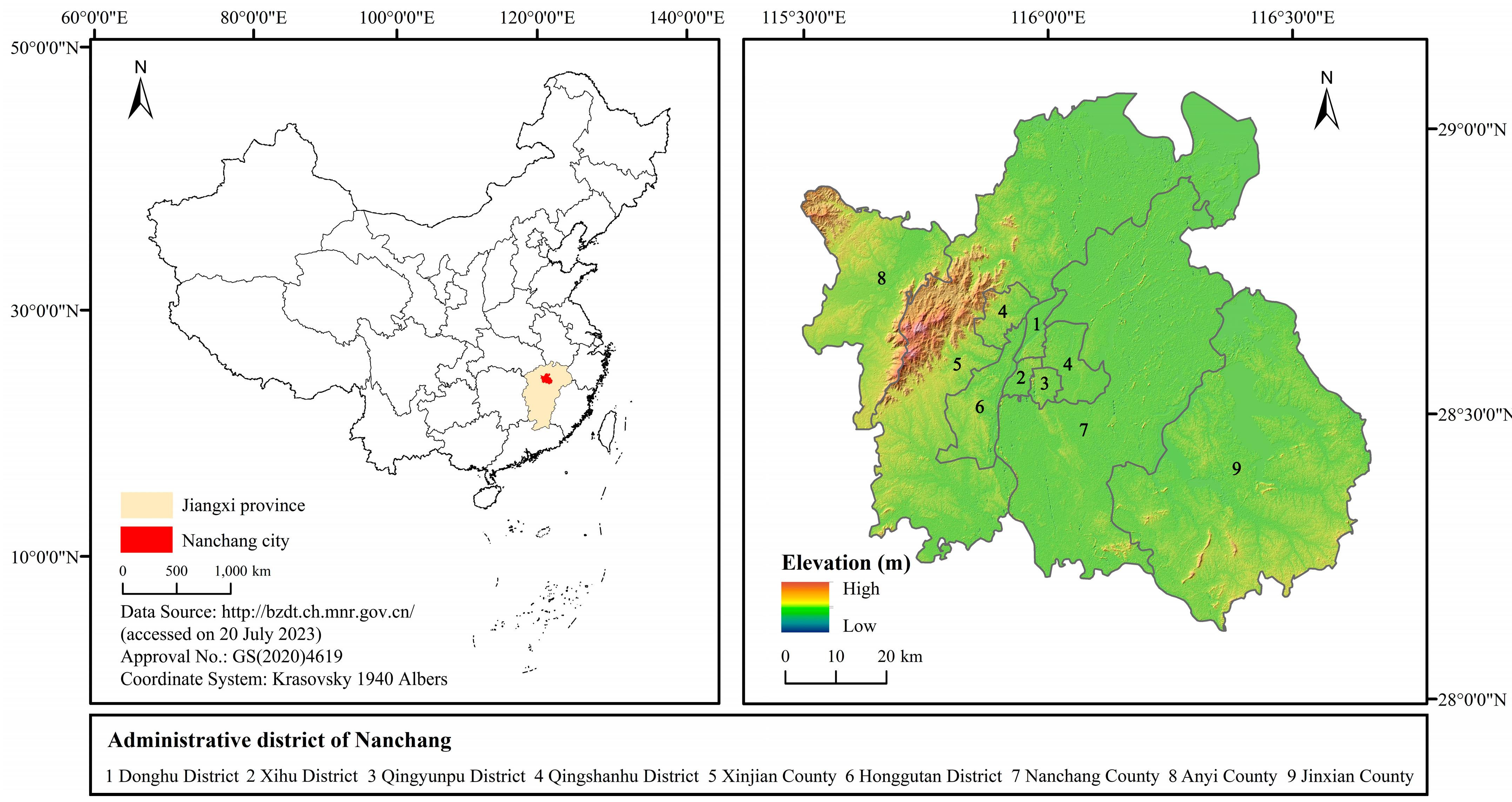
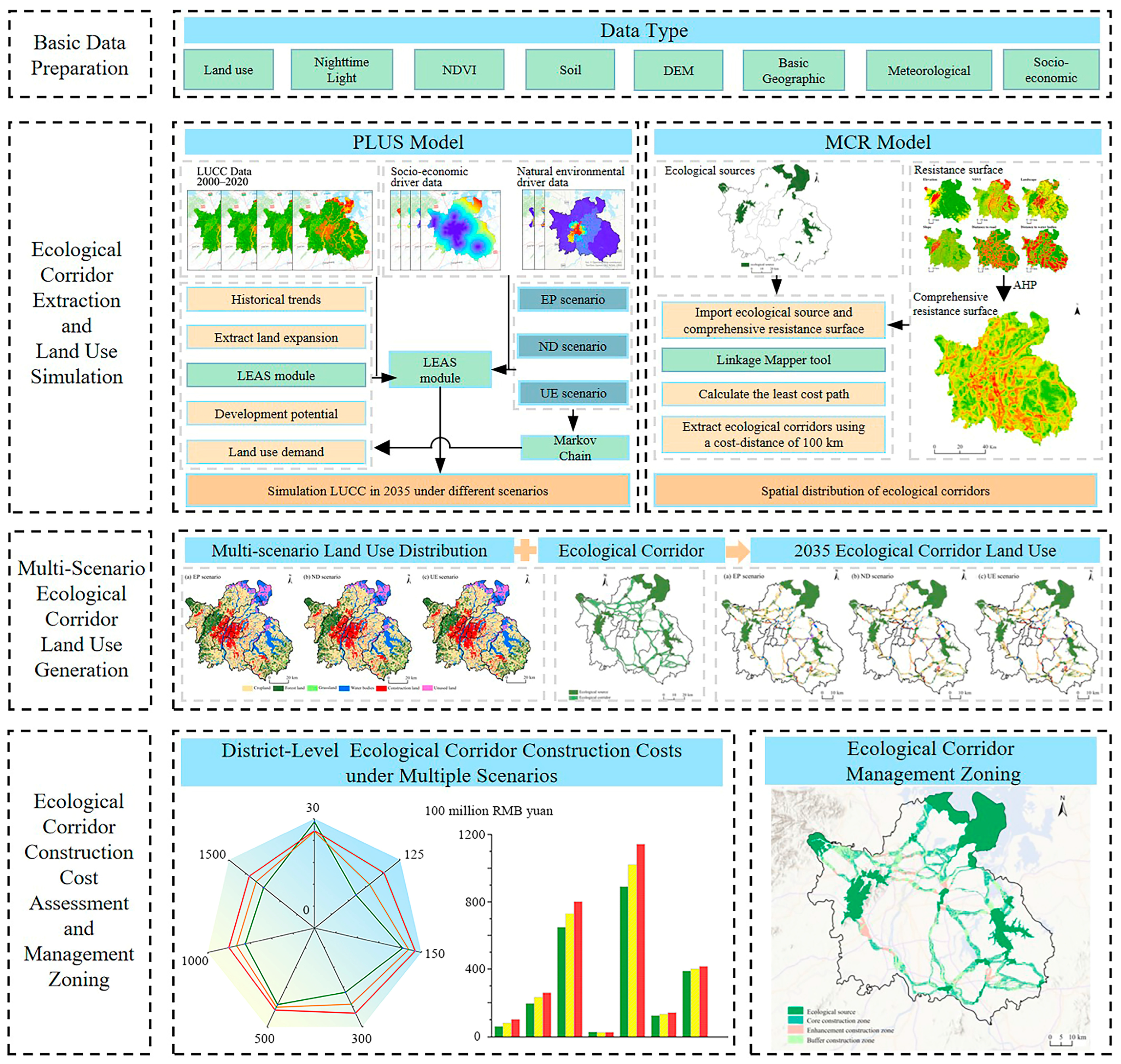
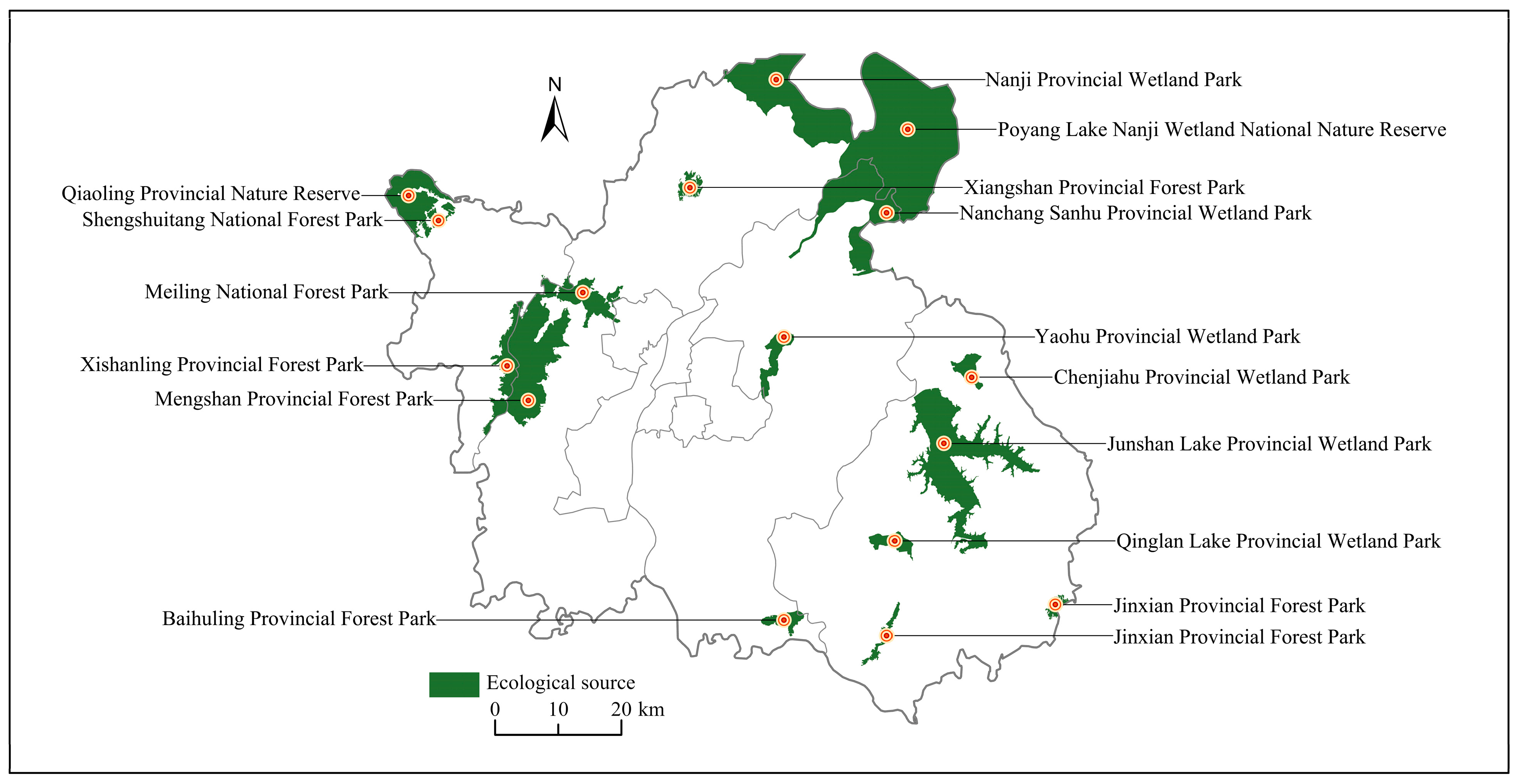
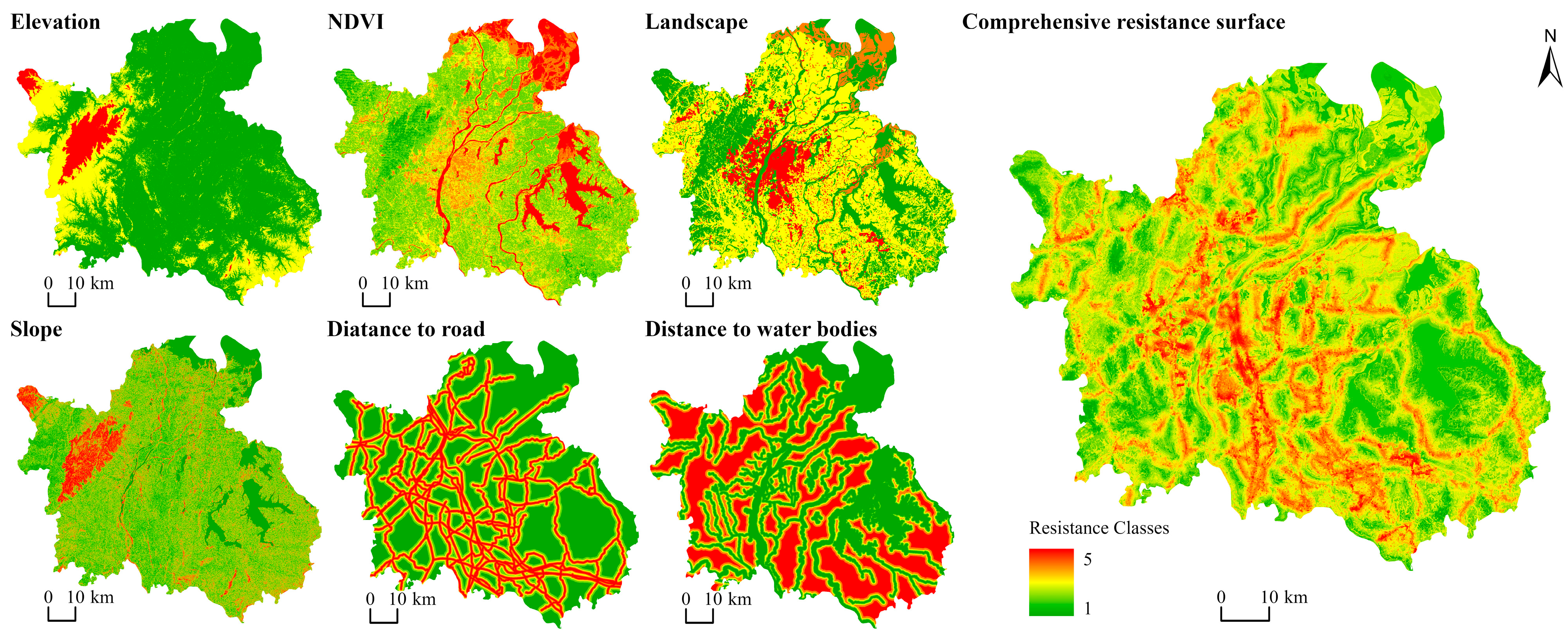

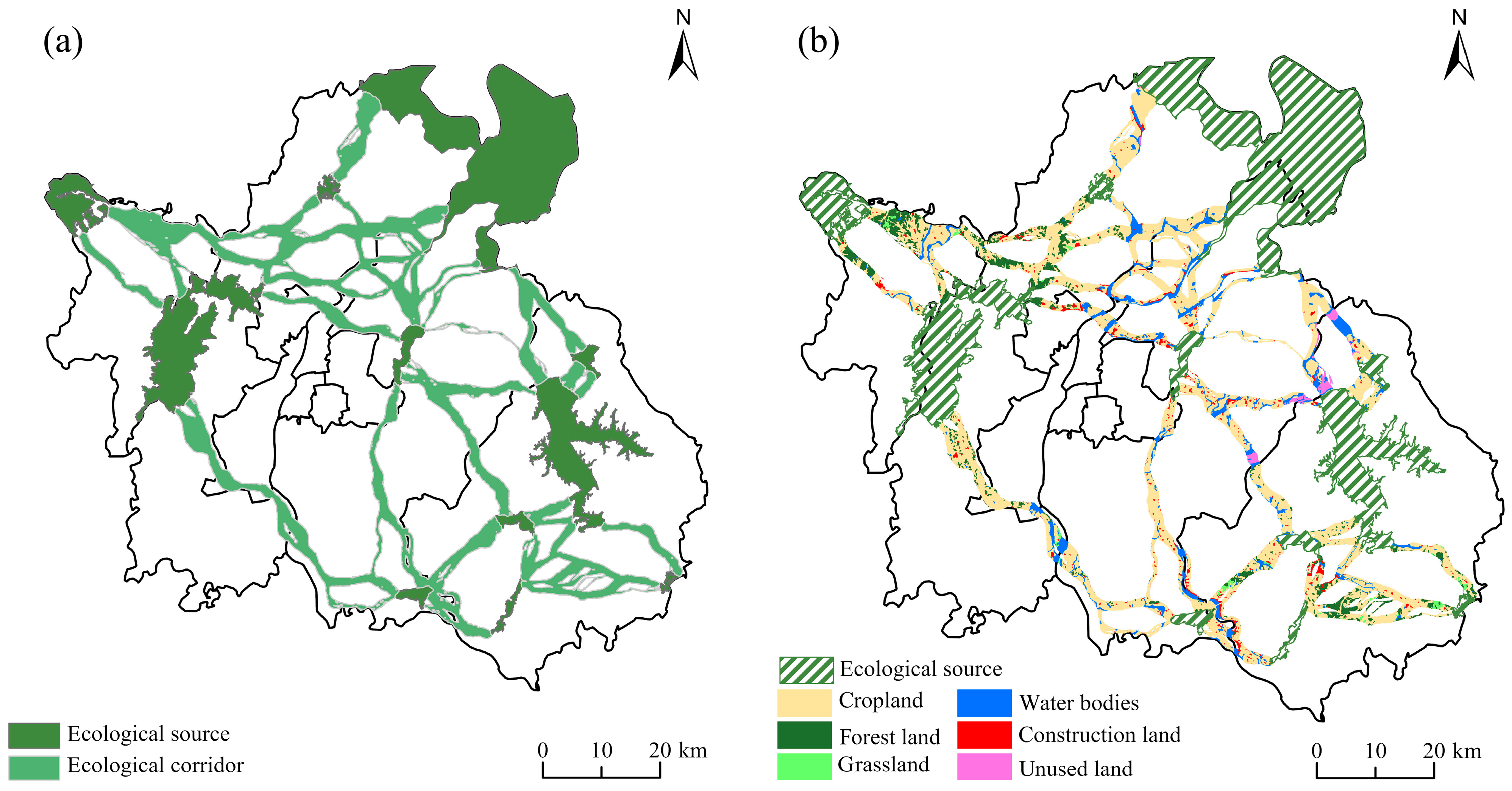
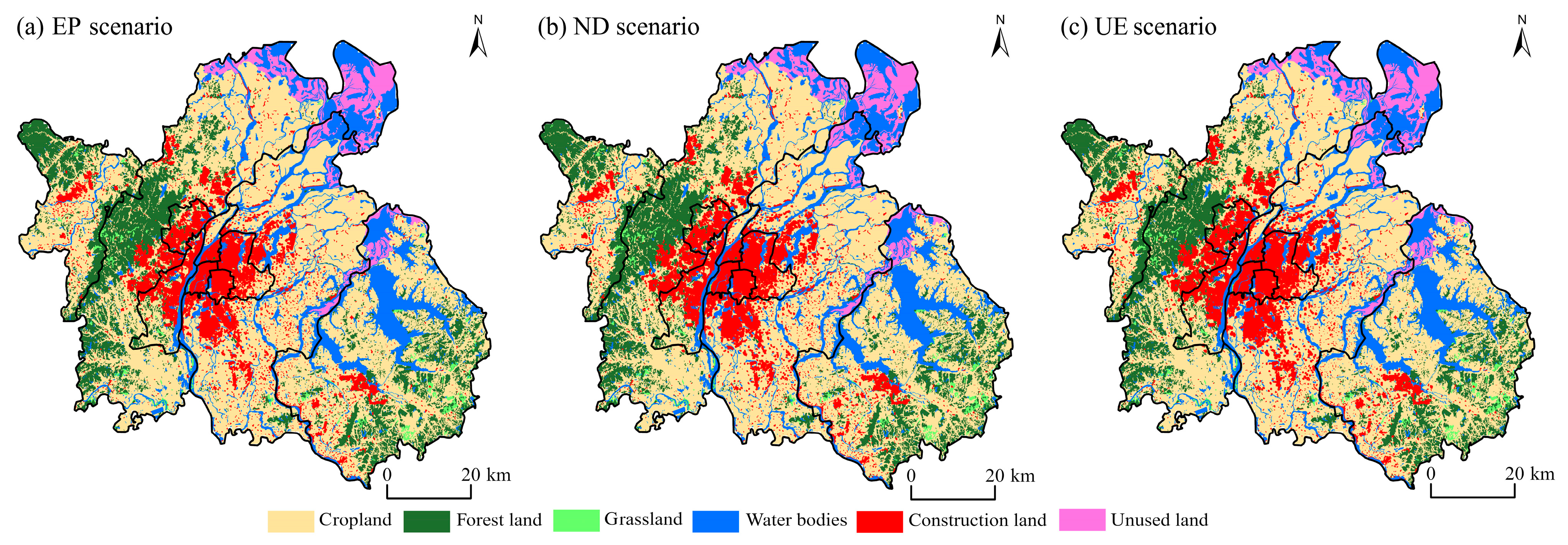

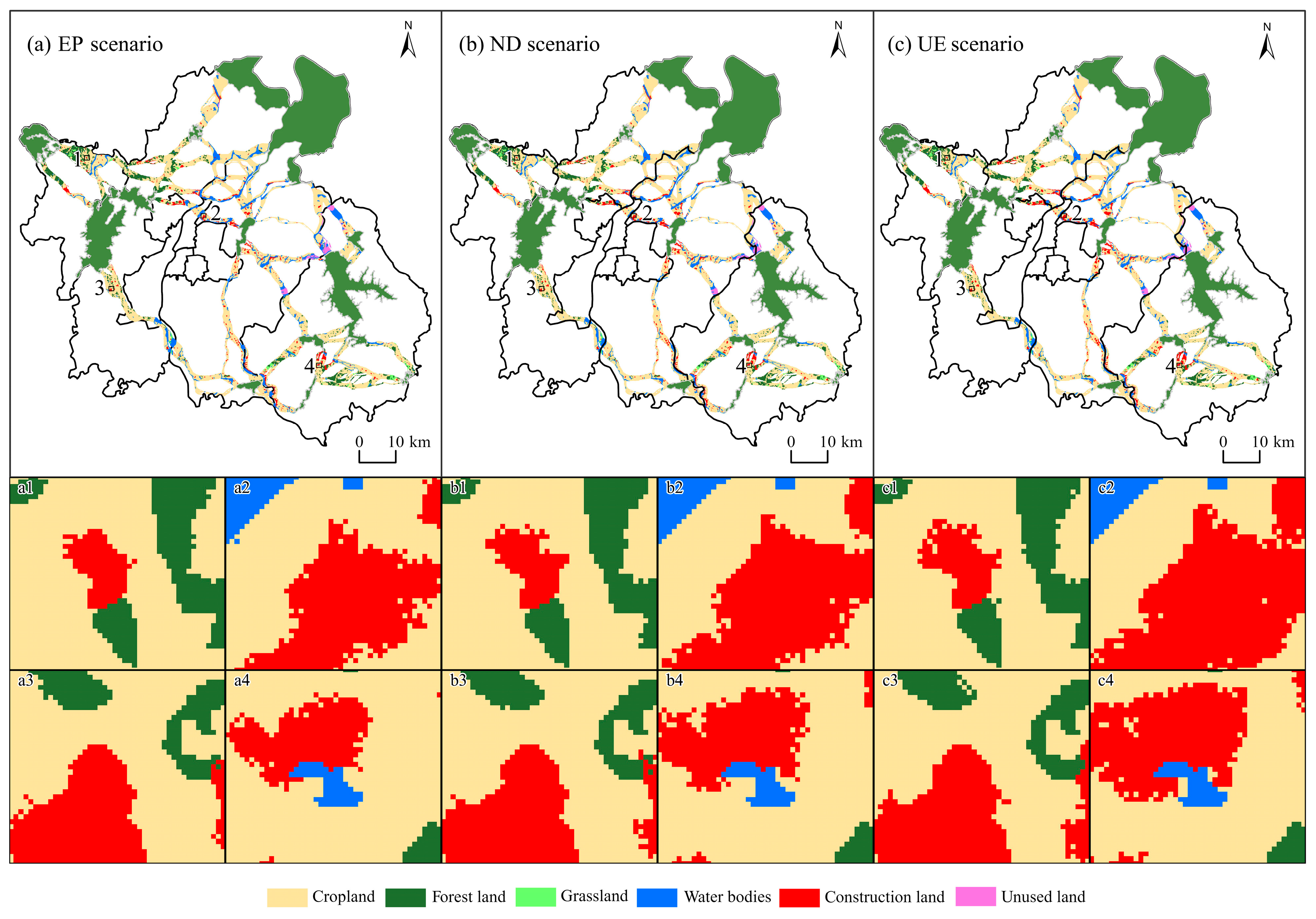
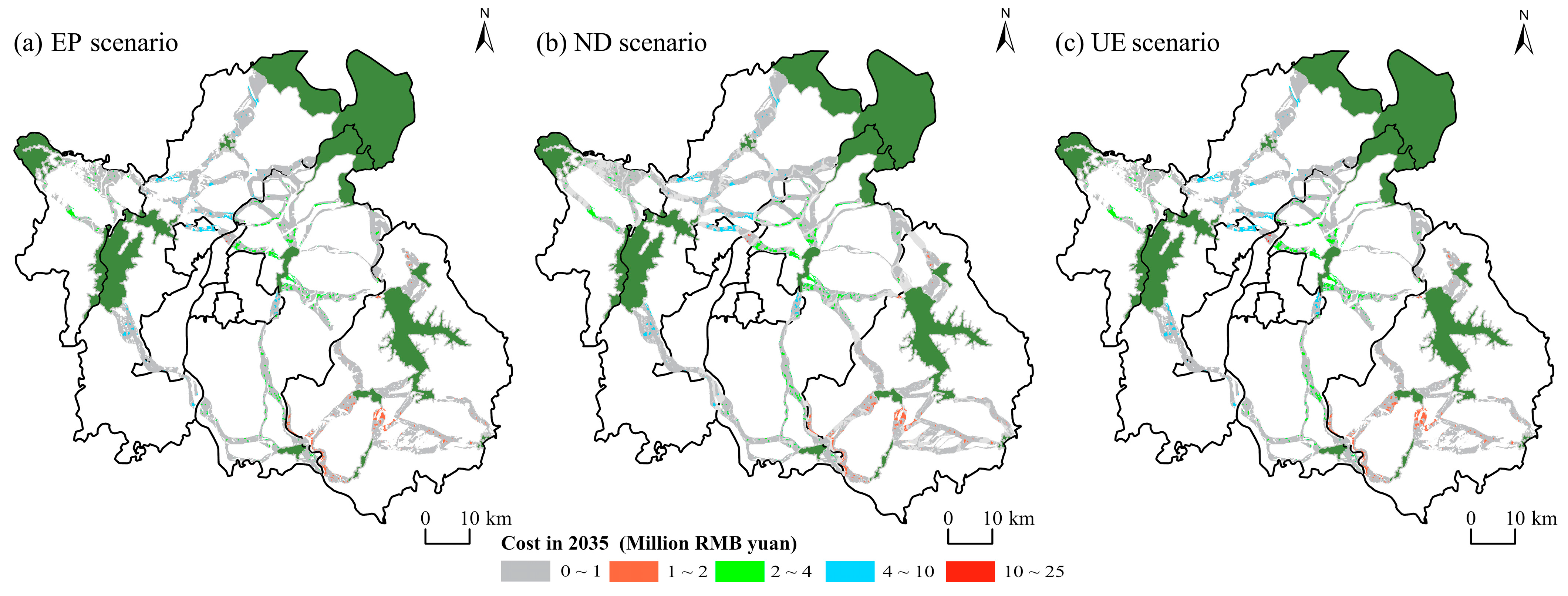
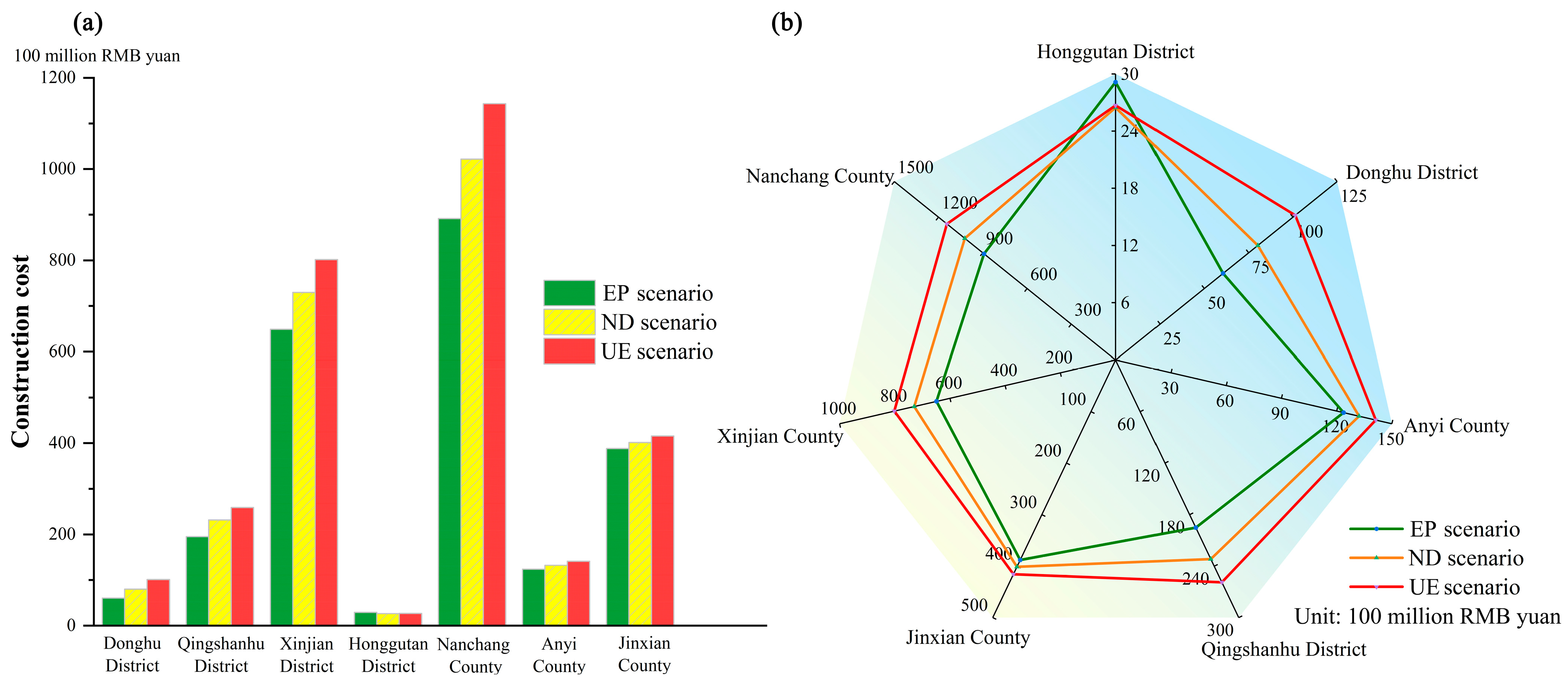
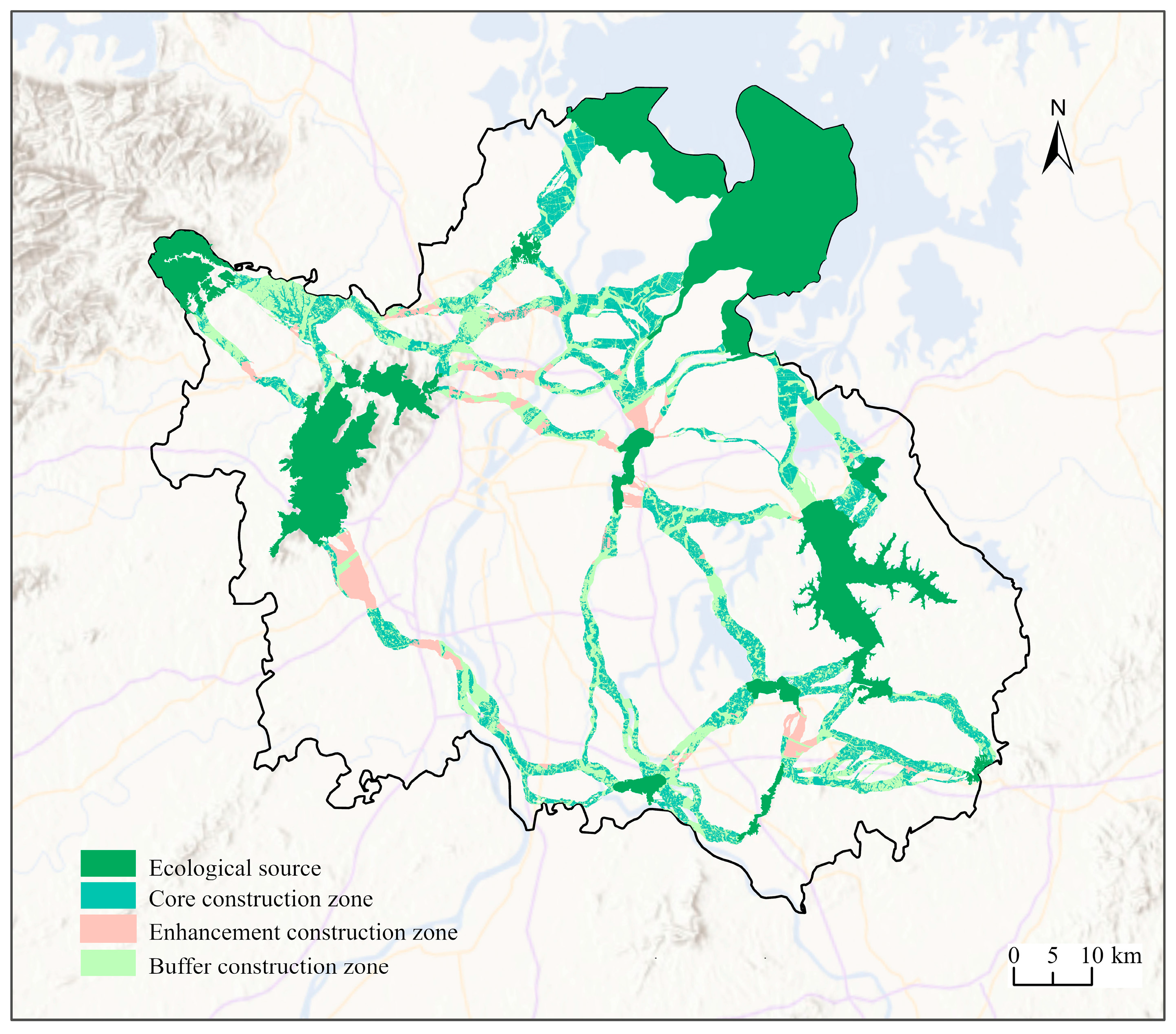
| Type | Data Subcategory | Data Sources | Data Type | Data Preprocessing |
|---|---|---|---|---|
| Land Use | —— | Resource and Environment Sciences https://www.resdc.cn/ accessed on 25 July 2023 | Raster (30 m) | crop, reclassify, and extract |
| Nighttime Light | —— | Raster (1 km) | crop, extract | |
| NDVI | —— | Raster (250 m) | ||
| Soil | —— | Raster (1 km) | ||
| DEM | —— | Geospatial Data Cloud https://www.gscloud.cn/ accessed on 25 July 2023 | Raster (30 m) | calculate, merge, crop, extract |
| Basic Geographic | Road Network Data | OpenStreetMap https://www.openstreetmap.org/ accessed on 25 July 2023 | Vector | crop, extract, Euclidean distance |
| River Network Data | Geospatial Data Cloud https://www.gscloud.cn/ accessed on 25 July 2023 | |||
| Administrative boundary data | National Geomatics Center of China https://www.ngcc.cn/ accessed on 25 July 2023 Ministry of Civil Affairs of the People’s Republic of China http://xzqh.mca.gov.cn/ accessed on 25 July 2023 | extract | ||
| Government locations | Baidu Maps https://map.baidu.com/ accessed on 25 July 2023 | Euclidean distance | ||
| “Three control line” data | Nanchang Natural Resources Department | extract | ||
| Nature reserves data | Geographic remote sensing ecological network platform http://www.gisrs.cn/ accessed on 25 July 2023 | merge | ||
| Meteorological | Precipitation Data | Resource and Environment Sciences and Data Center https://www.resdc.cn/ accessed on 25 July 2023 | Raster (1 km) | extract |
| Temperature Data | ||||
| Socio-economic | Population data | Resource and Environment Sciences and Data Center https://www.resdc.cn/ accessed on 25 July 2023 | Raster (1 km) | clip |
| GDP data | ||||
| Compensation for land requisition | Comprehensive land price list for land acquisition in Jiangxi Province https://www.jiangxi.gov.cn/ accessed on 25 July 2023 | Cross-sectional datasets | Calculate | |
| Construction land auction data | China Real Estate Information http://www.crei.com.cn/ accessed on 25 July 2023 | |||
| Industry output data | Jiangxi Statistical Yearbook Nanchang Statistical Yearbook |
| Resistance Factor | Weight | Grading Index | Resistance Value | Resistance Factor | Weight | Grading Index | Resistance Value |
|---|---|---|---|---|---|---|---|
| Elevation/m | 0.08 | <50 | 1 | Distance to road/m | 0.18 | <300 | 5 |
| 50~150 | 2 | 300~600 | 4 | ||||
| 150~250 | 3 | 600~900 | 3 | ||||
| 250~350 | 4 | 900~1500 | 2 | ||||
| >350 | 5 | >1500 | 1 | ||||
| Slope/° | 0.17 | <3 | 1 | Distance to water bodies/m | 0.17 | <300 | 1 |
| 3~8 | 2 | 300~600 | 2 | ||||
| 8~15 | 3 | 600~900 | 3 | ||||
| 15~25 | 4 | 900~1500 | 4 | ||||
| >25 | 5 | >1500 | 5 | ||||
| Landscape types | 0.21 | forest land | 1 | NDVI | 0.19 | 0~0.2 | 5 |
| Cropland, grassland | 2 | 0.2~0.4 | 4 | ||||
| unused land | 3 | 0.4~0.6 | 3 | ||||
| water bodies | 4 | 0.6~0.8 | 2 | ||||
| construction land | 5 | 0.8~1.0 | 1 |
| Type of Scenario | Scenario Description |
|---|---|
| Ecological protection (EP) | To enhance ecological protection in the land use simulation, transition probabilities from cropland and forest land to construction land were reduced by 30%, whereas those from grassland and water bodies to construction land were lowered by 20%. Conversely, the probability of reconverting construction land to forest land was increased by 10%. Moreover, the ecological redlines, permanent basic farmland, and areas outside the urban development boundaries, as delineated by the “three control lines” policy were designated as spatial constraints to restrict land-use conversions. |
| Natural development (ND) | The ND scenario was constructed without ecological or policy constraints, relying on historical land-use change rates from 2000 to 2015 to project future development trends. |
| Urban expansion (UE) | The development of the Greater Nanchang Metropolitan Area is expected to accelerate the expansion of construction land. Accordingly, under the UE scenario, transition probabilities from cropland, forest, and grassland to construction land were increased by 30%, whereas the probability of converting construction land back into forest land, grassland, and water bodies was decreased by 30%. |
| District | Compensation Standard for Cropland Acquisition (Yuan/m2) | Average Agricultural Output (Yuan/m2) | Construction Cost per Unit Area of Crop Land (Yuan/m2) | Average Acquisition Price of Construction Land (Yuan/m2) | Average Secondary and Tertiary Industries Output Value (Yuan/m2) | Construction Cost per Unit Area of Construction Land (Yuan/m2) |
|---|---|---|---|---|---|---|
| Donghu | 232.42 | 6.19 | 238.61 | 23,167.47 | 773.44 | 23,940.91 |
| Xihu | 381.90 | 388.09 | 12,645.71 | 13,419.15 | ||
| Qingyunpu | 305.85 | 312.04 | 15,780.01 | 16,553.45 | ||
| Qingshanhu | 210.00 | 216.19 | 3986.78 | 4760.22 | ||
| Xinjian | 78.72 | 84.91 | 4535.04 | 5308.48 | ||
| Honggutan | 139.16 | 145.35 | 10,111.43 | 10,884.87 | ||
| Nanchang | 85.90 | 92.09 | 2609.25 | 3382.69 | ||
| Anyi | 64.15 | 70.34 | 1430.51 | 2203.95 | ||
| Jinxian | 65.61 | 71.80 | 1026.24 | 1799.68 |
Disclaimer/Publisher’s Note: The statements, opinions and data contained in all publications are solely those of the individual author(s) and contributor(s) and not of MDPI and/or the editor(s). MDPI and/or the editor(s) disclaim responsibility for any injury to people or property resulting from any ideas, methods, instructions or products referred to in the content. |
© 2025 by the authors. Licensee MDPI, Basel, Switzerland. This article is an open access article distributed under the terms and conditions of the Creative Commons Attribution (CC BY) license (https://creativecommons.org/licenses/by/4.0/).
Share and Cite
Bi, M.; Zhong, Y.; Gong, D.; Xiao, Z. Multi-Scenario Land Use Simulation and Cost Assessment of Ecological Corridor Construction in Nanchang City. Remote Sens. 2025, 17, 3257. https://doi.org/10.3390/rs17183257
Bi M, Zhong Y, Gong D, Xiao Z. Multi-Scenario Land Use Simulation and Cost Assessment of Ecological Corridor Construction in Nanchang City. Remote Sensing. 2025; 17(18):3257. https://doi.org/10.3390/rs17183257
Chicago/Turabian StyleBi, Manyu, Yexi Zhong, Daohong Gong, and Zeping Xiao. 2025. "Multi-Scenario Land Use Simulation and Cost Assessment of Ecological Corridor Construction in Nanchang City" Remote Sensing 17, no. 18: 3257. https://doi.org/10.3390/rs17183257
APA StyleBi, M., Zhong, Y., Gong, D., & Xiao, Z. (2025). Multi-Scenario Land Use Simulation and Cost Assessment of Ecological Corridor Construction in Nanchang City. Remote Sensing, 17(18), 3257. https://doi.org/10.3390/rs17183257







